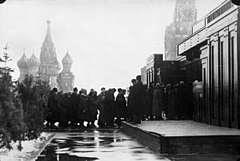Death and state funeral of Vladimir Lenin
_detail_01.jpg) Lenin's funeral (1925), by Isaak Brodsky (detail). | |
| Date | 27 January 1924 |
|---|---|
| Location | Red Square, Moscow, Soviet Union |
| Participants | RCP(b) leaders, relatives and followers. |
On 21 January 1924, at 18:50 EET, Vladimir Lenin, leader of the October Revolution and the first leader and founder of the Soviet Union, died in Gorki aged 53 after felling into a coma.[1] His official cause of death was recorded as an incurable disease of the blood vessels.[2] Lenin was given a state funeral and then buried in a specially erected mausoleum on 27 January. A commission of the Central Committee of the RCP(b) was in charge of organizing the funeral.
Funeral service
On 23 January, the coffin with Lenin's body was transported by train from Gorki to Moscow and displayed at the Hall of Columns in the House of the Unions, and it stayed there for three days.[3][4] On 27 January, the body of Lenin was delivered to Red Square, accompanied by martial music. There assembled crowds listened to a series of speeches delivered by Mikhail Kalinin, Grigory Zinoviev and Joseph Stalin, but notably not Leon Trotsky, who had been convalescing in the Caucasus.[4] Afterwards the body was placed into the vault of a temporary wooden mausoleum (soon to be replaced with present-day Lenin's Mausoleum), by the Kremlin Wall.[5] Despite the freezing temperatures, tens of thousands attended.[6]
The commander of the Moscow Garrison issued an order to place the guard of honour at the mausoleum. The people called it the "Number One Sentry". After the events of the 1993 Russian constitutional crisis, the guard of honour was disbanded.
Against protestations of Nadezhda Krupskaya, Lenin's widow, Lenin's body was embalmed to preserve it for long-term public display in the Red Square mausoleum.[7] During this process, Lenin's brain was removed; in 1925 an institute was established to dissect it, revealing that Lenin had suffered from severe sclerosis.[8]
Gallery
 Transport of Lenin's body to the Gorki railway station.
Transport of Lenin's body to the Gorki railway station. Lenin's funeral train (Locomotive U-127).
Lenin's funeral train (Locomotive U-127).
 Mikhail Tomsky, Mikhail Kalinin, Nadezhda Krupskaya and Jānis Rudzutaks at Lenin's funeral.
Mikhail Tomsky, Mikhail Kalinin, Nadezhda Krupskaya and Jānis Rudzutaks at Lenin's funeral..jpg) Lenin's Mausoleum (1924), by Isaak Brodsky.
Lenin's Mausoleum (1924), by Isaak Brodsky. The wooden version of Lenin's Mausoleum, March 1925.
The wooden version of Lenin's Mausoleum, March 1925. Guard of the MVOKU at the wooden version of Lenin's Mausoleum, 1924.
Guard of the MVOKU at the wooden version of Lenin's Mausoleum, 1924..jpeg) Lenin's Mausoleum, July 2006.
Lenin's Mausoleum, July 2006.
See also
References
- ↑ Fischer 1964, pp. 673–674; Shub 1966, p. 438; Rice 1990, p. 194; Volkogonov 1994, p. 435; Service 2000, pp. 478–479; White 2001, p. 176; Read 2005, p. 269.
- ↑ Volkogonov 1994, p. 435; Lerner, Finkelstein & Witztum 2004, p. 372.
- ↑ Fischer 1964, p. 674; Shub 1966, p. 439; Rice 1990, pp. 7–8; Service 2000, p. 479.
- 1 2 Rice 1990, p. 9.
- ↑ Shub 1966, p. 439; Rice 1990, p. 9; Service 2000, pp. 479–480.
- ↑ Volkogonov 1994, p. 440.
- ↑ Fischer 1964, p. 674; Shub 1966, p. 438; Volkogonov 1994, pp. 437–438; Service 2000, p. 481.
- ↑ Fischer 1964, pp. 625–626; Volkogonov 1994, p. 446.